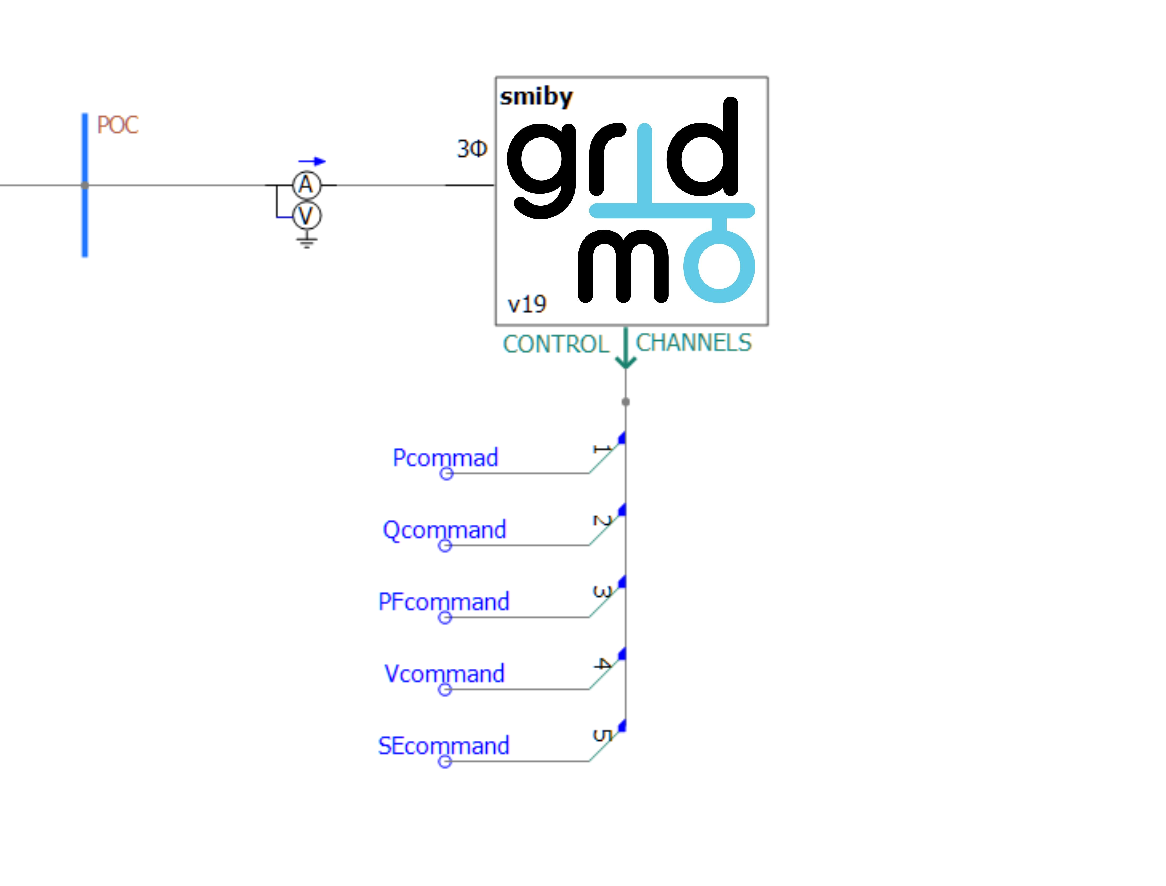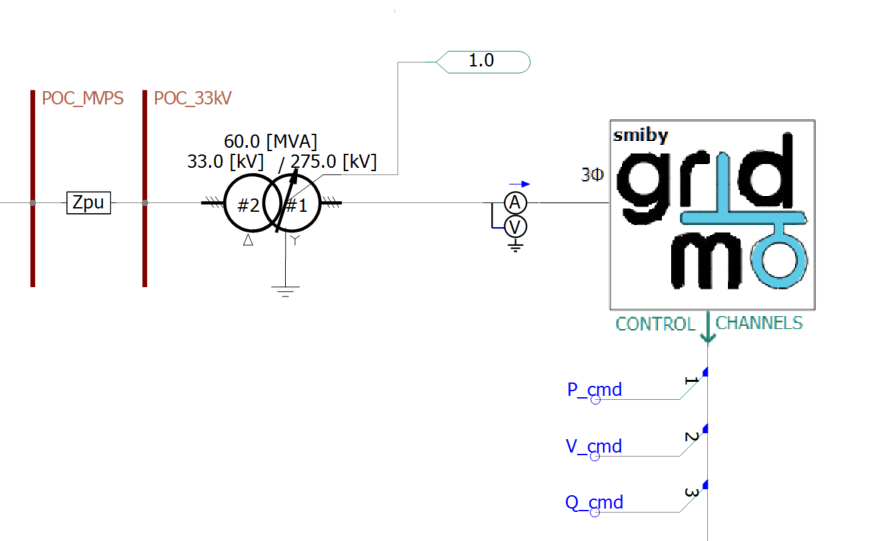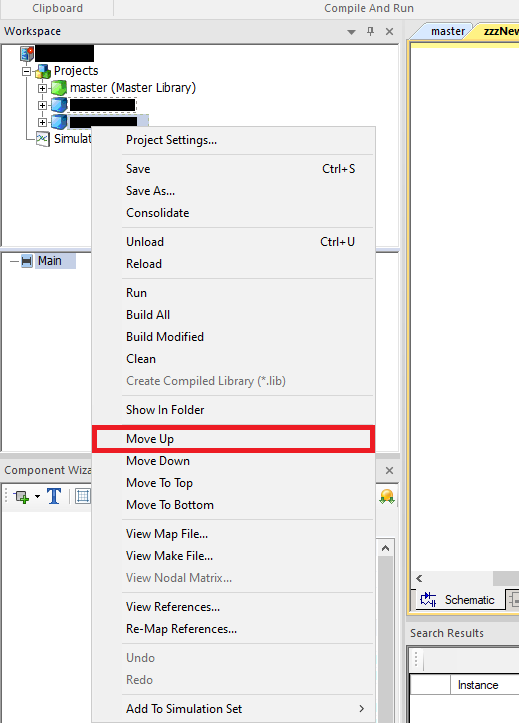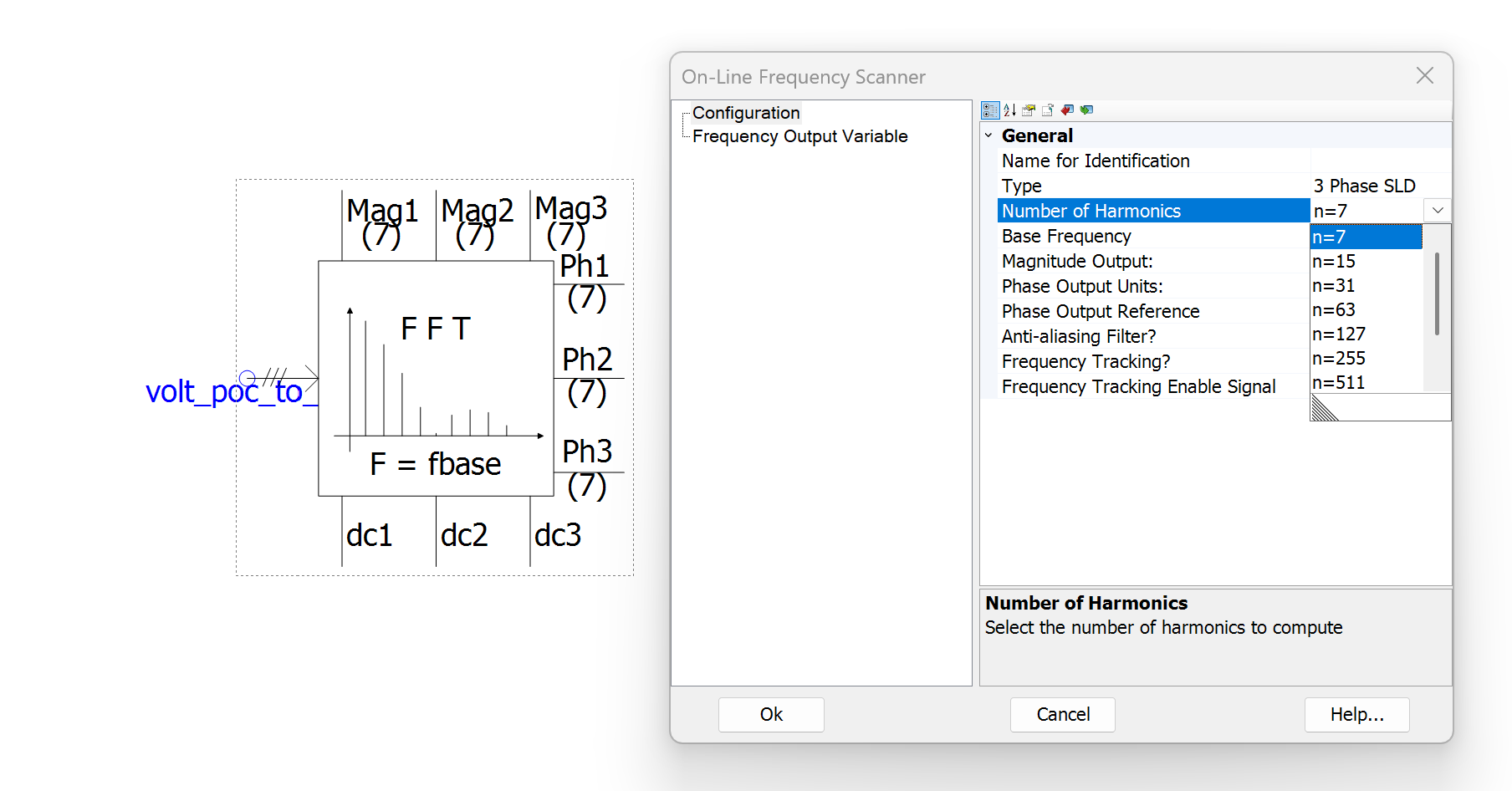PSCAD™ smiby

Last updated: 12 December 2025
Version: v24
Software required:
Background
smiby is a PSCAD™ Definition provided with the gridmo software platform which enables gridmo to easily interface with your PSCAD™ Workspace. smiby is a Thévenin equivalent source, used for SMIB studies, which can be controlled using the Grid controls. A simplified representation of smiby is shown below.

Adding smiby into a model
The video below states that smiby can be found in your gridmo Engine's Inputs folder - this is no longer the case.
Instead - please download the latest version of smiby using the DOWNLOAD MODEL button above.
Step 1: Disable/remove existing external grid representation
Disable or remove the existing external grid representation (if any) at the connection point.
Step 2: Add smiby
Add the smiby block into your PSCAD™ Workspace. Add a single smiby block in the same PSCAD™ Case file (.pscx) where your existing external grid representation was disabled/removed. The three phase electrical grid connection is on the left hand side of smiby. In your PSCAD™ Case file, connect this to your connection point using the PSCAD™ wire tool. An example of a correctly configured PSCAD™ Case file is shown below.

gridmo requires that the PSCAD™ Case file (.pscx) which contains the smiby block is first in the list of Case files. If required, right click the relevant Case file and select 'Move Up', as shown below, to move the Case file to the top of the list of Case files.

Step 3: Configure control channels
In addition to providing a controllable Thévenin equivalent source, smiby also contains 12 independent multi-purpose control channels which can be controlled using the CONTROL Command. Control channels should normally be used for values which you may want to vary during a PSCAD™ simulation. Examples of common control channels:
- Active power setpoint
- Reactive power setpoint
- Voltage control mode
- Voltage setpoint
- Source energy (e.g. wind speed, solar irradiance)
In your PSCAD™ Case file, connect these control channels to your generating system using the PSCAD™ wire tool and Data Signal Array Tap.
In the smiby parameter window, configure the following settings for each control channel:
- Enable/disable: This defines whether the control channel is enabled or disabled.
- Scale: This defines the scaling applied to any
CONTROLCommands (i.e. control channel output =CONTROLCommand value x scale). This scale is not applied to the default value. - Defaults: This is the control channel output value used if there are no
CONTROLCommands for this channel.
Depending on the definition of an externally defined or black-boxed PSCAD™ models, you can use the control channels as parameters by defining the channel with a name and adding the value into the parameters box.
Step 4: Configure smiby parameters
Right click on the smiby block and navigate to 'Edit Parameters'. In the 'Project settings' section, set the following values considering the requirements of your generating system:
- Voltage base (
float): Connection point base voltage [kV]. - Frequency base (
float): Base frequency [Hz]. - Project rated active power (
float): The combined maximum amount of active power that the generating system can deliver at the connection point [MW]. This value is used in combination with plant SCR Commands. - Active current id base (
float): Base active power used in Id calculation. This value is often set as the maximum amount of active power that the generating system is rated to deliver at the connection point [MW]. - Reactive current iq base (
float): Base active power used in Iq calculation. This value is often set as the maximum amount of apparent power that the generating system is rated to deliver at the connection point [MVAr]. - Single phase current base [
float]: Current used for single phase current base output channels [A].
In the 'Advanced' section of the smiby parameters, the apparent power base has been set to 100 MVA by default. Note that if you are benchmarking with PSS®E and your PSS®E model has a system base which is not 100 MVA, you must update this apparent power base in smiby to match with the system base used in PSS®E.
From smiby versions v20 and onwards, the circuit breaker at the POC can be controlled (i.e. for asset switch-off tests) using the following commands:
// If smiby v22 or newer, use the following commands:
SET, CNAME=smiby, PARAM=open_poc_cb, VAL=0 // Close circuit breaker (put generator in service)
SET, CNAME=smiby, PARAM=open_poc_cb, VAL=1 // Open circuit breaker (take generator out of service)
// If smiby v20 or v21, use the following commands:
SET, CNAME=POC_BUS_OFF, VAL=0 // Close circuit breaker (put generator in service)
SET, CNAME=POC_BUS_OFF, VAL=1 // Open circuit breaker (take generator out of service)
Using smiby's metering channels
The smiby block has several built-in output channels which can be used:
Voltages
// Three phase RMS voltage [p.u. on base voltage] at the connection point
OUTPUT, TITLE=smiby_POC_VOLT, VAL=V, NAME=i_put_name_here
// Three phase RMS voltage [p.u. on base voltage] at the infinite bus
OUTPUT, TITLE=smiby_INF_VOLT, VAL=V, NAME=i_put_name_here
// Single phase RMS voltage [p.u. on base voltage] at the connection point
OUTPUT, TITLE=smiby_POC_VA, VAL=V, NAME=i_put_name_here
OUTPUT, TITLE=smiby_POC_VB, VAL=V, NAME=i_put_name_here
OUTPUT, TITLE=smiby_POC_VC, VAL=V, NAME=i_put_name_here
// Positive, negative and zero sequence voltage [p.u. on base voltage configured in smiby] at the connection point
OUTPUT, TITLE=smiby_POC_V_pos_seq, VAL=V, NAME=i_put_name_here
OUTPUT, TITLE=smiby_POC_V_neg_seq, VAL=V, NAME=i_put_name_here
OUTPUT, TITLE=smiby_POC_V_zero_seq, VAL=V, NAME=i_put_name_here
Currents
// Single phase RMS current [p.u. on base current configured in smiby] at the connection point
OUTPUT, TITLE=smiby_POC_IA, VAL=I, NAME=i_put_name_here
OUTPUT, TITLE=smiby_POC_IB, VAL=I, NAME=i_put_name_here
OUTPUT, TITLE=smiby_POC_IC, VAL=I, NAME=i_put_name_here
// Positive, negative and zero sequence current [p.u. on base current configured in smiby] at the connection point
OUTPUT, TITLE=smiby_POC_I_pos_seq, VAL=I, NAME=i_put_name_here
OUTPUT, TITLE=smiby_POC_I_neg_seq, VAL=I, NAME=i_put_name_here
OUTPUT, TITLE=smiby_POC_I_zero_seq, VAL=I, NAME=i_put_name_here
// Three phase RMS active current [p.u. on base current configured in smiby] at the connection point
OUTPUT, TITLE=smiby_POC_ID, VAL=I, NAME=i_put_name_here
// Positive sequence active current [p.u. on base current configured in smiby] at the connection point
OUTPUT, TITLE=smiby_POC_ID_pos_seq, VAL=I, NAME=i_put_name_here
// Negative sequence active current [p.u. on base current configured in smiby] at the connection point
OUTPUT, TITLE=smiby_POC_ID_neg_seq, VAL=I, NAME=i_put_name_here
// Three phase RMS reactive current [p.u. on base current configured in smiby] at the connection point
OUTPUT, TITLE=smiby_POC_IQ, VAL=I, NAME=i_put_name_here
// Positive sequence reactive current [p.u. on base current configured in smiby] at the connection point
OUTPUT, TITLE=smiby_POC_IQ_pos_seq, VAL=I, NAME=i_put_name_here
// Negative sequence reactive current [p.u. on base current configured in smiby] at the connection point
OUTPUT, TITLE=smiby_POC_IQ_neg_seq, VAL=I, NAME=i_put_name_here
Powers
// Active power [MW] and reactive power [MVAr] at the connection point
OUTPUT, TITLE=smiby_POC_P, VAL=PQS, NAME=i_put_name_here
OUTPUT, TITLE=smiby_POC_Q, VAL=PQS, NAME=i_put_name_here
// Power factor [generator convention] at the connection point
OUTPUT, TITLE=smiby_POC_PF, VAL=PF, NAME=i_put_name_here
Click here for details on how gridmo calculates power factor.
Channel readback
// Read back from smiby's output channels (e.g. to validate that the output channels are working)
OUTPUT, TITLE=smiby_CH1, NAME=i_put_name_here
OUTPUT, TITLE=smiby_CH2, NAME=i_put_name_here
OUTPUT, TITLE=smiby_CH3, NAME=i_put_name_here
OUTPUT, TITLE=smiby_CH4, NAME=i_put_name_here
OUTPUT, TITLE=smiby_CH5, NAME=i_put_name_here
OUTPUT, TITLE=smiby_CH6, NAME=i_put_name_here
OUTPUT, TITLE=smiby_CH7, NAME=i_put_name_here
OUTPUT, TITLE=smiby_CH8, NAME=i_put_name_here
OUTPUT, TITLE=smiby_CH9, NAME=i_put_name_here
OUTPUT, TITLE=smiby_CH10, NAME=i_put_name_here
OUTPUT, TITLE=smiby_CH11, NAME=i_put_name_here
OUTPUT, TITLE=smiby_CH12, NAME=i_put_name_here
Ratios
// Short circuit ratio [Sfault / Pmax]
OUTPUT, TITLE=smiby_POC_SCR, NAME=i_put_name_here
// Reactance to resistance X/R ratio [X/R]
OUTPUT, TITLE=smiby_POC_XR, NAME=i_put_name_here
// Positive sequence ratio (Ipos/Vpos) at the connection point
OUTPUT, TITLE=smiby_POC_pos_seq_ratio, NAME=i_put_name_here
// Negative sequence ratio (Ineg/Vneg) at the connection point
OUTPUT, TITLE=smiby_POC_neg_seq_ratio, NAME=i_put_name_here
Other
// Connection point frequency [Hz]
OUTPUT, TITLE=smiby_POC_FREQ, VAL=F, NAME=i_put_name_here
// Connection point voltage angle [degrees]
OUTPUT, TITLE=smiby_POC_ANGLE, VAL=ANGLE, NAME=i_put_name_here
// Angle between voltage and reactive power [degrees] at the connection point
OUTPUT, TITLE=smiby_POC_VQ_phase, NAME=i_put_name_here
Over-voltage snubber circuit
In versions of smiby earlier than v18, the following optional mode was called 'pre-insertion resistors' and worked in a similar way, however the resistance target was not dependent on the SCR and X/R ratio.
The VDISTURBANCE command controls the smiby block to apply a disturbance to the connection point. Under-voltages are applied via a fault block in PSCAD™, whereas over-voltages are applied by switching in/out an ideal capacitor. A capacitive load block in PSCAD™ is not suitable as it cannot be changed at runtime, meaning it limits to a single over-voltage event per simulation.
As PSCAD™ is an EMT tool, switching in an ideal capacitor can cause substantial oscillation of the RMS voltage at the connection point, especially under low SCR conditions.
To mitigate this, a non-linear snubber circuit can be activated in the smiby block to dampen the oscillations caused by the ideal capacitor. The snubber circuit is a resistor connected in series with the capacitor. The resistor's resistance starts at the critical damping value (given the SCR and X/R) and decays rapidly after switched in. The snubber circuit is only active when a capacitor is switched in for an over-voltage disturbance.
However, due to the non-linear nature of the snubber circuit, there may be a damped initial rise time which is longer than the result from RMS tools. The rise time may be up to 75 ms at very high SCR values or for severe overvoltages.
To activate the snubber circuit, set the Use snubber circuit to dampen oscillations? to Yes in the VDISTURBANCE section of smiby, or alternatively use the following gridmo command in your PSCAD™ node.
SET, CNAME=smiby, PARAM=cap_capcharge2_enabled, VAL=1 // turn on snubber circuit
FFT frequency measurement
By default, the On-Line Frequency Scanner component within smiby which performs a Fast Fourier Transform (FFT) of the frequency measurement uses 7 harmonics for sampling (from smiby versions v24 and greater). For most simulations, this should be sufficient. However you may wish to increase this for some simulations where you may observe false positives for system collapse due to extreme aliasing. Note that increasing this sampling rate will be computationally demanding and may increase simulation time.

Updating smiby to a new version
Updating smiby may overwrite any of your custom modifications to smiby. In general, we recommend not making any changes to the smiby block or OEM libraries so that newer versions may be accommodated easily.
Revision history
Version 24 | 12 December 2025
New- Added FFT block for calculating the magnitude of oscillations at a particular frequency for oscillation rejection tests.
- Removed stability resistor and circuit breaker for speed improvements as they are no longer required from gridmo engine versions > 1.5.0.
- Changed the breaker closed resistance of all internal circuit breakers to 0.006 ohms for speed improvements as ideal circuit breakers are no longer required from gridmo engine versions > 1.5.0.
- Decreased sampling rate of all On-Line Frequency Scanner components from 31 harmonics to 7 harmonics for speed improvements as 31 harmonics are only required in rare instances.
- Replaced distance factor circuit breakers with variable impedances of very high/minimum impedance to act as circuit breakers for speed improvements.
- Replaced VDIST_OV circuit single phase circuit breakers with variable impedances of very high/minimum impedance to act as circuit breakers for speed improvements.
- Added logic to fault calculations which was causing a rare singularity error when the fault impedance is 1 ohm.
Version 23 | 5 August 2025
Improvements- Updated
VDISTURBANCEcalculation methodology to have higher accuracy on target residual voltage when applying faults with very low X/R ratios.
Version 22 | 2 July 2025
New- Added output channels for instantaneous single-phase voltage and currents.
- Added new parameter to allow direct control of the point of connection circuit breaker.
- Added new parameter to enable/disable high frequency sampling (1 kHz) for all point of connection metering channels - only typically used for tests which are sensitive to aliasing, such as voltage oscillation tests.
- Updated smiby default parameters to better align with gridmo's WECC-Solar model, default SCR raised from 3 to 10, all smiby base values updated to align with a typical 175 MW solar farm.
- Increased sampling rate of point of connection FFT frequency measurement from 7 harmonics to 31, to increase sampling rate to prevent false positives for system collapse due to extreme aliasing caused by the low sampling rate.
- Changed the impedance of all internal circuit breakers from 0.0005 ohms to 0 ohms to prevent slight benchmarking mismatches under really high SCR conditions (or really low base voltages).
Version 21 | 22 May 2025
New- Added functionality for unbalanced overvoltage disturbances.
- Added zero sequence impedance specification in
Zero sequence impedancetab underExternal impedanceusing user input for R0/R1 ratio and X0/X1 ratio.
- Switched on over-voltage snubber circuit by default.
- Added large resistances to prevent rare singularity error on point of connection circuit breaker switching commands.
- Set maximum absolute value capacitance to avoid singularity errors during initialisation where unbalanced overvoltage disturbances are enabled.
Version 20 | 25 April 2025
New- Added circuit breaker to the point of connection for asset switch-off tests.
- Added output channels for positive and negative sequence ratios (Ipos/Vpos and Ineg/Vneg).
- Added minimised plots for POC metering signals and all frequently used smiby channels - to help with model debugging.
- smiby can now support angle playback and voltage oscillation rejection tests with phase-angle modulation at the same time.
- Fixed angle playback logic for calculating infinite bus angle (angle value was previously incorrectly doubled - but only affects projects which did not use the default infinite bus angle of
0). - Moved
Apparent power base [MVA]field toAdvancedtab in smiby parameters and renamedBase valuestab toProject settings. - Fault impedance for a phase to phase fault was incorrectly double the desired impedance (other unbalanced fault types not affected).
Version 19 | 4 November 2024
- Fixed incorrect base value applied to positive/negative reactive current (IQ) and positive/negative active reactive current (ID), output channel unit is now consistent with total IQ and ID.
Version 18 | 31 October 2024
- Changed to integer version number (rather than linking smiby version to the version of the engine when it was updated).
- Added positive, negative and zero sequence voltage and current output channels.
- Fixed incorrect unit conversion on positive/negative reactive current (IQ) and positive/negative active reactive current (ID) output channels (was radians, should have been degrees).
- Low SCR initialisation mode now on by default for new smiby blocks added to a workspace.
- Added large resistances to prevent rare singularity error on
SIMPLEFAULTandVDISTURBANCECommands. - Pre-insertion resistance setting (for
VDISTURBANCE) and distance factor setting (for all faults) was greyed out unless faults were enabled - now always available. - Replaced non-linear pre-insertion resistance mode (for
VDISTURBANCE) with automatic snubber circuit which auto-calculates impedances required to achieve critical damping (based on the SCR), with a non-linear resistance ramp-out to prevent benchmarking mismatch during the disturbance. - Fixed inductive kickback experienced on some models with transmission line blocks (caused by
VDISTURBANCECB opening at any current incorrectly set to true, rather than a zero crossing).
Version 1.4.13.2 | 13 May 2024
- smiby's automatic infinite bus voltage not used to bias relative voltage steps.
- smiby's automatic infinite bus voltage mode incorrectly applies a fixed ramp rate to all subsequent voltage changes in a simulation.
Version 1.4.13 | 7 May 2024
- Added automatic infinite bus voltage calculation capability.
Version 1.4.12 | 15 April 2024
- Expanded low-SCR initialisation mode options. New modes include infinite bus voltage ramps, and infinite bus voltage and SCR ramps.
Version 1.4.11 | 20 March 2024
- Updated power factor calculation logic to improve handling for indeterminate cases (0/0).
To see the changelog for older changes to this model, please see the main gridmo change log here.